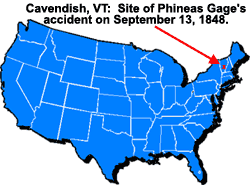Neuroscience For Kids
Phineas Gage, Revealed!
July 24, 2009
 Most people who study the brain have heard of Mr. Phineas Gage. Mr. Gage
was the unfortunate railroad worker who on September 13, 1848, suffered a
brain injury when an iron tamping rod was shot accidentally through his
head. Phineas had a dramatic personality change after his injury. He went
from being a hard-working, capable foreman to a gruff, obnoxious man who
could not hold a job. The unfortunate changes in Mr. Gage's personality
have provided scientists with important information about the function of
the brain's frontal lobes and made Phineas quite famous.
Most people who study the brain have heard of Mr. Phineas Gage. Mr. Gage
was the unfortunate railroad worker who on September 13, 1848, suffered a
brain injury when an iron tamping rod was shot accidentally through his
head. Phineas had a dramatic personality change after his injury. He went
from being a hard-working, capable foreman to a gruff, obnoxious man who
could not hold a job. The unfortunate changes in Mr. Gage's personality
have provided scientists with important information about the function of
the brain's frontal lobes and made Phineas quite famous.
 Although a "life mask" of Mr. Gage was made, there were no known
pictures of Phineas...until now! Jack and Beverly Wilgus, two
photographers and photographic collectors in Maryland, had an old image of
a man they thought was a whaler. When they posted the image on the
Internet, people who knew about whaling told the Wilgus' that the iron rod
held by the man was not a harpoon. So, if the man was not a whaler, who
was he and why was he holding the iron rod? Another viewer of the image
suggested that the man could be Phineas Gage.
Although a "life mask" of Mr. Gage was made, there were no known
pictures of Phineas...until now! Jack and Beverly Wilgus, two
photographers and photographic collectors in Maryland, had an old image of
a man they thought was a whaler. When they posted the image on the
Internet, people who knew about whaling told the Wilgus' that the iron rod
held by the man was not a harpoon. So, if the man was not a whaler, who
was he and why was he holding the iron rod? Another viewer of the image
suggested that the man could be Phineas Gage.
Jack and Beverly did not know anything about Mr. Gage, but they did some research to find out about their mystery man. They learned about the 1848 railroad accident and thought that the image could be that of Phineas Gage. To confirm their suspicions, they compared their old photograph (a daguerreotype) to a photograph of the life mask made of Mr. Gage's face.
The similarities between photographs were striking! Both photographs show a distinctive scar in the same place on the forehead of the man. Marks on the man's face and the shape of the man's mouth also matched. Finally, text on the tamping rod in their photograph matched that of text from the actual tamping rod that is displayed at the Countway Library of Medicine in Boston.
Jack and Beverly are convinced! They had their man, Mr. Phineas Gage, and have published their discovery in the Journal of the History of the Neurosciences.

| Did you know? | A life mask is made by draping gauze on a person's face and then pouring plaster on top. After the plaster dries (10-15 minutes), the mask is lifted. |
References and more information:
- Wilgus, J. and Wilgus, B., Face to face with Phineas Gage, J. Hist. Neurosci., 18:340-345, 2009.
- Lobes of the Brain - Neuroscience for Kids
- Phineas Gage Information Page - Dr. Malcolm Macmillan, School of Psychology Deakin University, Victoria. Australia. (A special "thank you" to Dr. Macmillan who let me know about the discovery of the Phineas daguerreotype.)
- Phineas Gage: Neuroscience's Most Famous Patient
Copyright © 1996-2013, Eric H. Chudler All Rights Reserved.
